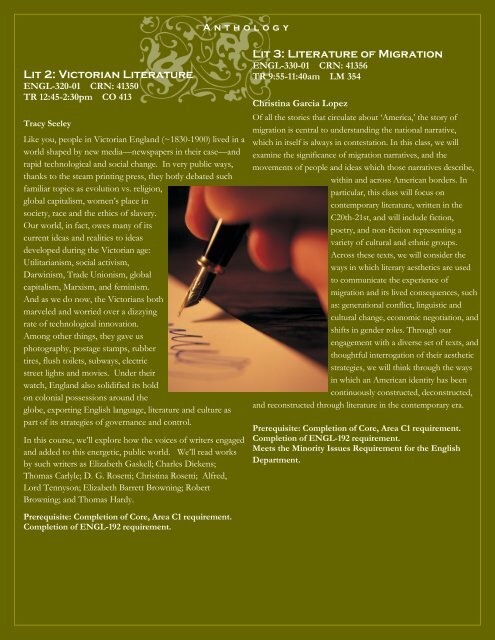Anthology
Create successful ePaper yourself
Turn your PDF publications into a flip-book with our unique Google optimized e-Paper software.
Lit 2: Victorian Literature<br />
ENGL-320-01 CRN: 41350<br />
TR 12:45-2:30pm CO 413<br />
Tracy Seeley<br />
Like you, people in Victorian England (~1830-1900) lived in a<br />
world shaped by new media—newspapers in their case—and<br />
rapid technological and social change. In very public ways,<br />
thanks to the steam printing press, they hotly debated such<br />
familiar topics as evolution vs. religion,<br />
global capitalism, women’s place in<br />
society, race and the ethics of slavery.<br />
Our world, in fact, owes many of its<br />
current ideas and realities to ideas<br />
developed during the Victorian age:<br />
Utilitarianism, social activism,<br />
Darwinism, Trade Unionism, global<br />
capitalism, Marxism, and feminism.<br />
And as we do now, the Victorians both<br />
marveled and worried over a dizzying<br />
rate of technological innovation.<br />
Among other things, they gave us<br />
photography, postage stamps, rubber<br />
tires, flush toilets, subways, electric<br />
street lights and movies. Under their<br />
watch, England also solidified its hold<br />
on colonial possessions around the<br />
globe, exporting English language, literature and culture as<br />
part of its strategies of governance and control.<br />
In this course, we’ll explore how the voices of writers engaged<br />
and added to this energetic, public world. We’ll read works<br />
by such writers as Elizabeth Gaskell; Charles Dickens;<br />
Thomas Carlyle; D. G. Rosetti; Christina Rosetti; Alfred,<br />
Lord Tennyson; Elizabeth Barrett Browning; Robert<br />
Browning; and Thomas Hardy.<br />
Lit 3: Literature of Migration<br />
ENGL-330-01 CRN: 41356<br />
TR 9:55-11:40am LM 354<br />
Christina Garcia Lopez<br />
Of all the stories that circulate about ‘America,’ the story of<br />
migration is central to understanding the national narrative,<br />
which in itself is always in contestation. In this class, we will<br />
examine the significance of migration narratives, and the<br />
movements of people and ideas which those narratives describe,<br />
within and across American borders. In<br />
particular, this class will focus on<br />
contemporary literature, written in the<br />
C20th-21st, and will include fiction,<br />
poetry, and non-fiction representing a<br />
variety of cultural and ethnic groups.<br />
Across these texts, we will consider the<br />
ways in which literary aesthetics are used<br />
to communicate the experience of<br />
migration and its lived consequences, such<br />
as: generational conflict, linguistic and<br />
cultural change, economic negotiation, and<br />
shifts in gender roles. Through our<br />
engagement with a diverse set of texts, and<br />
thoughtful interrogation of their aesthetic<br />
strategies, we will think through the ways<br />
in which an American identity has been<br />
continuously constructed, deconstructed,<br />
and reconstructed through literature in the contemporary era.<br />
Prerequisite: Completion of Core, Area C1 requirement.<br />
Completion of ENGL-192 requirement.<br />
Meets the Minority Issues Requirement for the English<br />
Department.<br />
Prerequisite: Completion of Core, Area C1 requirement.<br />
Completion of ENGL-192 requirement.<br />
14


